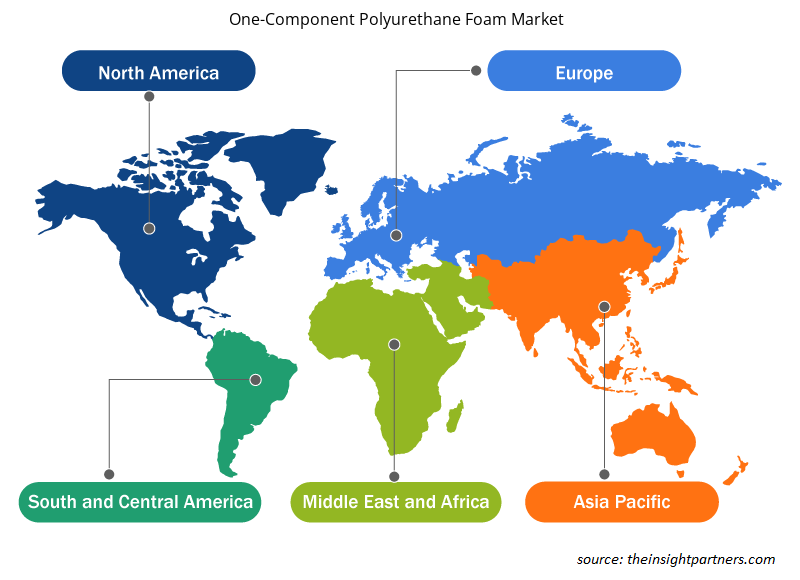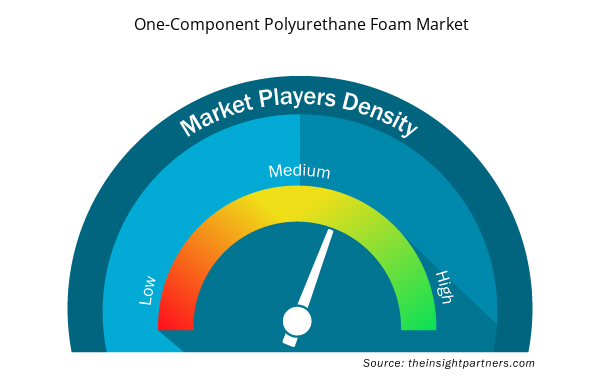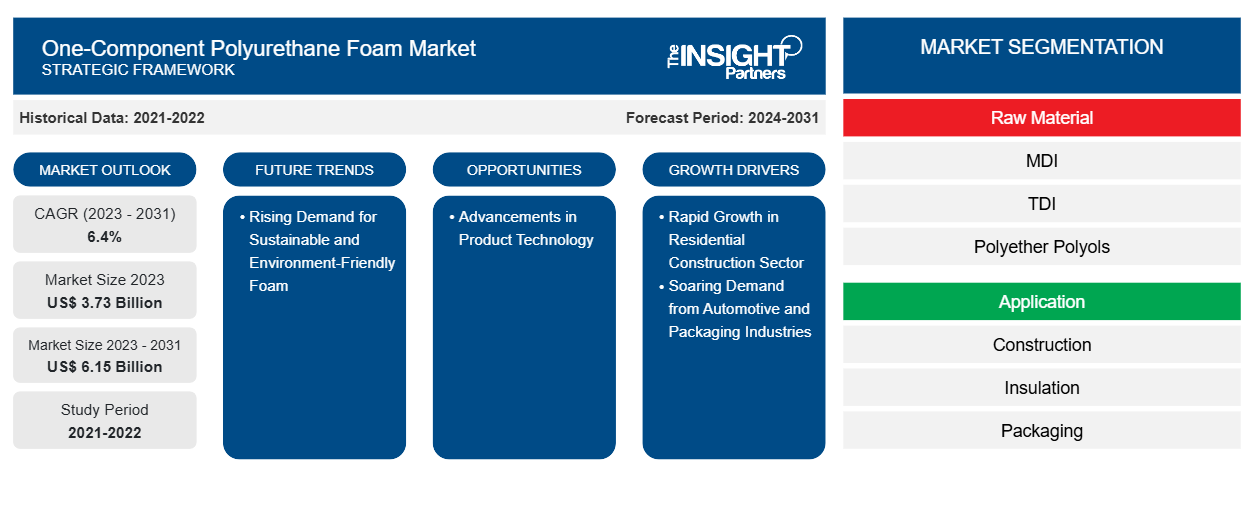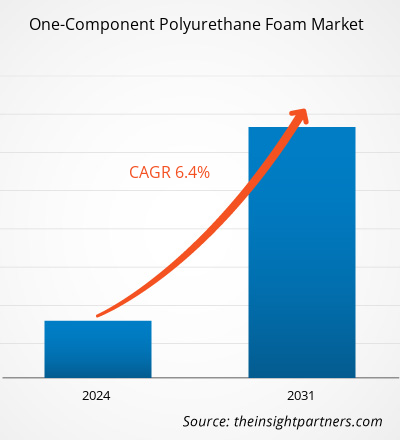单组分聚氨酯泡沫市场规模预计将从 2023 年的 37.3 亿美元增至 2031 年的 61.5 亿美元。预计 2023-2031 年期间,该市场的复合年增长率将达到 6.4%。由于城市群的扩张,住宅项目大量增加,而政府出台的支持性政策导致汽车和包装行业的需求激增,这些都是单组分聚氨酯泡沫市场当前的变革趋势
单组分聚氨酯泡沫市场分析
单组分聚氨酯 (PU) 泡沫的多功能性不仅限于绝缘,还可用于密封、粘合和填充等其他应用。单组分 PU 泡沫具有可靠的粘合性、防潮性和耐用性,是确保住宅建筑结构完整性和使用寿命的宝贵资产。在汽车行业,单组分 PU 泡沫用于提供声音和振动阻尼、密封接头或空腔以防止水和油渗透,并在发生碰撞时提供能量吸收。由于向电动汽车过渡、经济增长、人口增加、政府对汽车生产的支持以及对该行业的投资增加等因素,世界各国的汽车行业都在增长。应用技术的进步改进了分配设备和自动化应用系统,简化了单组分 PU 泡沫的使用。这些创新减少了浪费、提高了精度并降低了劳动力成本,使 PU 泡沫成为更具成本效益的解决方案。因此,单组分 PU 泡沫的配制和应用方面的持续技术进步为市场开辟了新的增长机会。
单组分聚氨酯泡沫市场概况
单组分聚氨酯泡沫具有出色的隔热和隔音性能,易于使用,并能有效提高建筑物的能源效率。该产品的便利性和效率推动了它的普及。单组分聚氨酯泡沫通常包装在加压罐中,可直接使用,无需混合或专用设备。这种易用性使其对承包商和 DIY 爱好者都极具吸引力。人们对节能建筑的日益重视大大推动了对单组分聚氨酯泡沫的需求。它能够提供气密密封并改善建筑物的热性能,使其成为建筑商和承包商的首选。汽车行业也是单组分聚氨酯泡沫市场的一个重要领域。该材料因其隔音和减震性能而被使用,这对于提高车辆的舒适性和耐用性至关重要。随着行业不断创新并寻求更高效的建筑和制造解决方案,单组分聚氨酯泡沫市场将继续扩大。
定制此报告以满足您的需求
您可以免费定制任何报告,包括本报告的部分内容、国家级分析、Excel 数据包,以及为初创企业和大学提供优惠和折扣
- 获取此报告的关键市场趋势。这个免费样品将包括数据分析,从市场趋势到估计和预测。
单组分聚氨酯泡沫市场驱动因素和机遇
汽车和包装行业需求飙升
汽车和包装行业是单组分聚氨酯泡沫的主要终端使用行业之一。在汽车行业中,单组分聚氨酯泡沫用于提供隔音效果、密封接头和空腔以防止水和油的进入;它在碰撞过程中吸收高冲击能量。由于向电动汽车的过渡、经济增长和人口增加,汽车行业在全球范围内不断发展,政府对汽车生产的支持政策和不断增加的投资在该行业中尤为突出。根据国际汽车制造商组织 (OICA) 的数据,全球乘用车销量从 2022 年的 8480 万辆增加到 2023 年的 9350 万辆。2022 年 12 月,由于零售额增加,中国乘用车市场扩大。此外,印度在国内需求和出口方面拥有强大的汽车行业。在印度, 2000 年 4 月至 2022 年 12 月期间,汽车行业累计获得约 341.1 亿美元的股权 FDI 流入。为了满足不断增长的需求,几家汽车制造商已开始在印度的各个行业领域进行大量投资。2023 年 2 月,日产和雷诺宣布计划在未来 3-5 年内在印度投资 6 亿美元,以扩大其在乘用车和电动汽车市场的份额。所有这些因素都在推动印度汽车行业的增长,进而推动单组分聚氨酯泡沫市场的发展。
单组分聚氨酯泡沫具有出色的缓冲性能和高耐用性,是保护易碎和贵重物品的理想材料,可降低损坏风险。电子商务和网上购物的激增导致全球包裹运输量空前增加。这种繁荣需要坚固高效的包装解决方案来确保运输过程中的产品安全。因此,世界各国汽车工业和包装的强劲增长正在推动对单组分聚氨酯泡沫的需求。
产品技术的进步
配方和应用技术的创新显著提高了聚氨酯泡沫的性能特征,使其用途更广泛、效率更高。现代单组分聚氨酯泡沫经过精心设计,具有出色的附着力、更快的固化时间以及更好的隔热和隔音性能。这些改进扩大了泡沫在建筑、汽车和包装等各个行业的适用性,从而推动了更广泛的应用。在建筑领域,技术进步推动了具有增强的耐火性和环境可持续性的聚氨酯泡沫的发展。这些新配方符合更严格的建筑规范和法规,特别是在防火和减少挥发性有机化合物排放方面。这些改进使单组分聚氨酯泡沫对寻求可靠、合规和环保的绝缘和密封解决方案的建筑商和承包商具有吸引力。建筑行业向可持续建筑实践的转变进一步扩大了对先进聚氨酯泡沫产品的需求。能够更高效、更一致地应用泡沫的能力在大型制造和建筑项目中尤其有利,因为时间和资源优化至关重要。随后,单组分聚氨酯泡沫的配制和应用技术的不断进步为市场开辟了新的增长机会。
单组分聚氨酯泡沫市场报告细分分析
有助于得出单组分聚氨酯泡沫市场分析的关键部分是原材料、应用和最终用途。
- 根据原材料,单组分聚氨酯泡沫市场细分为二苯基甲烷二异氰酸酯、甲苯二异氰酸酯、聚醚多元醇、聚酯多元醇等。聚醚多元醇部分在 2023 年占据最大的市场份额。
- 根据应用,市场分为建筑、绝缘、包装、汽车等。2023 年,建筑行业占据了最大的市场份额。
从最终用途来看,市场分为住宅和商业两大类。2023 年,商业领域将占据市场主导地位。
单组分聚氨酯泡沫市场份额按地区分析
单组分聚氨酯泡沫市场报告的地理范围主要分为五个区域:北美、亚太、欧洲、中东和非洲、南美和中美。
2023 年,亚太地区占据了单组分聚氨酯泡沫市场份额的主导地位。由于聚氨酯泡沫具有出色的隔热性能并能有效密封缝隙和裂缝,因此它是该地区一系列住宅、商业和工业项目的建筑商和开发商最喜欢的选择。根据 2030 年可持续发展目标,亚洲开发银行宣布了其计划,通过在亚太地区建设弹性基础设施和促进创新来促进包容性和可持续的工业化。亚太地区的许多政府都将基础设施发展项目列为优先事项,因此对交通网络、能源设施和公共设施等大型项目进行了多项投资。根据工业和内部贸易促进部的报告,印度政府宣布了其计划,通过智慧城市任务、支持性政策、大量预算分配和灵活的 FDI 规范来促进基础设施和建筑服务。
2023 年,北美占据单组分聚氨酯泡沫市场的第二大份额。由于建筑业的发展和多家知名汽车制造商的存在,美国单组分聚氨酯泡沫市场正在大幅增长。根据 OICA 的数据,美国商用车产量从 2022 年的 1010 万辆增加到 2023 年的 1060 万辆,比 2022 年增长近 16%。此外,美国对电动汽车的需求正在显着增长。根据国际能源署 2022 年的一份报告,2021 年该国电动汽车的销量比 2020 年翻了一番(660 万辆);电动汽车在汽车总销量中的份额增长了 4.5%。因此,建筑和汽车行业的持续扩张预计将对北美的单组分聚氨酯泡沫市场产生积极影响。
单组分聚氨酯泡沫市场区域洞察
Insight Partners 的分析师已详尽解释了预测期内影响单组分聚氨酯泡沫市场的区域趋势和因素。本节还讨论了北美、欧洲、亚太地区、中东和非洲以及南美和中美洲的单组分聚氨酯泡沫市场细分和地理分布。

- 获取单组分聚氨酯泡沫市场的区域特定数据
单组分聚氨酯泡沫市场报告范围
| 报告属性 | 细节 |
|---|---|
| 2023 年的市场规模 | 37.3亿美元 |
| 2031 年市场规模 | 61.5亿美元 |
| 全球复合年增长率(2023 - 2031) | 6.4% |
| 史料 | 2021-2022 |
| 预测期 | 2024-2031 |
| 涵盖的领域 | 按原材料
|
| 覆盖地区和国家 | 北美
|
| 市场领导者和主要公司简介 |
|
市场参与者密度:了解其对商业动态的影响
单组分聚氨酯泡沫市场正在快速增长,这得益于终端用户需求的不断增长,而这些需求又源于消费者偏好的不断变化、技术进步以及对产品优势的认识不断提高等因素。随着需求的增加,企业正在扩大其产品范围,进行创新以满足消费者的需求,并利用新兴趋势,从而进一步推动市场增长。
市场参与者密度是指在特定市场或行业内运营的企业或公司的分布情况。它表明在给定市场空间中,相对于其规模或总市场价值,有多少竞争对手(市场参与者)存在。
在单组分聚氨酯泡沫市场运营的主要公司有:
- 汉高股份公司
- 西卡公司
- 陶氏化学公司
- 巴斯夫
- 亨斯迈公司
免责声明:上面列出的公司没有按照任何特定顺序排列。

- 获取单组分聚氨酯泡沫市场顶级关键参与者概述
单组分聚氨酯泡沫市场新闻和最新发展
通过收集一手和二手研究的定性和定量数据来评估单组分聚氨酯泡沫市场,其中包括重要的公司出版物、协会数据和数据库。以下列出了单组分聚氨酯泡沫市场的一些发展情况:
- 波兰建筑化学品供应商 Selena Group 和塑料制造商科思创结成战略联盟,旨在推动建筑行业的可持续变革,他们联合各自的专业知识,生产出一系列更具可持续性的聚氨酯泡沫,以增强建筑隔热性能。此次合作体现了他们共同的承诺,即采用共同创造的方法,引领建筑行业的变革,符合欧洲绿色协议、Fit for 55 的原则以及到 2050 年实现建筑行业碳中和的总体目标。(来源:科思创,新闻稿,2023 年 9 月)
- 亨斯迈的汽车专家为公司的电池解决方案组合添加了一系列新型轻质耐用聚氨酯泡沫技术,这些技术专为封装和固定安装在电动汽车 (EV) 电池中的电池而开发。新系列还包括可用作电池模块或电池组中的可塑封装材料的产品。(来源:亨斯迈,新闻稿,2024 年 4 月)
单组分聚氨酯泡沫市场报告覆盖范围和交付成果
“单组分聚氨酯泡沫市场规模和预测(2021-2031 年)”报告对以下领域进行了详细的市场分析:
- 单组分聚氨酯泡沫市场规模及全球、区域和国家层面所有主要细分市场的预测
- 单组分聚氨酯泡沫市场趋势以及市场动态,如驱动因素、限制因素和关键机遇
- 详细的波特五力分析和 SWOT 分析
- 单组分聚氨酯泡沫市场分析涵盖主要市场趋势、全球和区域框架、主要参与者、法规和最新市场发展
- 行业格局和竞争分析,涵盖市场集中度、热图分析、知名企业以及单组分聚氨酯泡沫市场的最新发展
- 详细的公司简介
- 历史分析(2 年)、基准年、预测(7 年)及复合年增长率
- PEST 和 SWOT 分析
- 市场规模价值/数量 - 全球、区域、国家
- 行业和竞争格局
- Excel 数据集

Report Coverage
Revenue forecast, Company Analysis, Industry landscape, Growth factors, and Trends

Segment Covered
This text is related
to segments covered.

Regional Scope
North America, Europe, Asia Pacific, Middle East & Africa, South & Central America

Country Scope
This text is related
to country scope.
常见问题
Within residential construction, the versatility of one-component polyurethane (polyurethane) foam extends beyond insulation to other applications such as sealing, bonding, and filling. It is commonly used to seal gaps around windows and doors, adhere to drywall panels, fill voids in concrete structures, and soundproof interior spaces. The ability of one-component polyurethane foam to provide reliable adhesion, moisture resistance, and durability makes it a valuable asset in ensuring the structural integrity and longevity of residential buildings.
Asia Pacific is the largest region of global one-component polyurethane foam market. As the region continues to witness an increase in automobile production and sales, there is an increasing demand for vehicles equipped with advanced soundproofing and vibration-damping features. According to the International OICA, Asia-Oceania's vehicle production increased from 50 million in 2022 to 55.1 million in 2023.
In terms of end use, the one-component polyurethane foam market is bifurcated into residential and commercial. In 2023, the residential segment is projected to grow at the fastest CAGR. One-component polyurethane foam is commonly employed in sealing joints around windows and doors, filling gaps around plumbing and electrical penetrations, and insulating HVAC ducts.
Based on raw material, the one-component polyurethane foam market is segmented into methylene diphenyl diisocyanate, toulene diisocyanate, polyether polyols, polyester polyols, and others. In 2023, the polyether polyols segment held the largest market share and is expected to register the highest CAGR from 2023 to 2031. Polyether polyols provide one-component polyurethane foam with excellent moisture resistance, low viscosity, and high reactivity, which are crucial for achieving uniform foam expansion and curing.
The major players operating in the global one-component polyurethane foam market are Henkel AG & Co KGaA; Sika AG; The Dow Chemical Co; BASF SE; Huntsman Corp; Industrial Products LTD.; Selena Group; BOSTIK BENELUX B.V. (Den Braven); Tremco CPG Inc; and Soudal Group.
One-component polyurethane foam is typically with little or no volatile organic compounds (VOC). However, propellants used in some of the aerosol products do contribute to the VOC content. The propellant gas in canned one-component polyurethane foam can contain hazardous air pollutants (HAPs), which have replaced HCFC-22 since 2002. On application, the gas that expels the foam from the aerosol cans is completely released into the atmosphere, contributing to air pollution and posing health risks to both workers and end users.
Trends and growth analysis reports related to Chemicals and Materials : READ MORE..
The List of Companies - One-Component Polyurethane Foam Market
- Henkel AG & Co KGaA
- Sika AG
- The Dow Chemical Co
- BASF SE
- Huntsman Corp
- Industrial Products LTD.
- Selena Group
- BOSTIK BENELUX B.V. (Den Braven)
- Tremco CPG Inc
- Soudal Group
The Insight Partners performs research in 4 major stages: Data Collection & Secondary Research, Primary Research, Data Analysis and Data Triangulation & Final Review.
- Data Collection and Secondary Research:
As a market research and consulting firm operating from a decade, we have published and advised several client across the globe. First step for any study will start with an assessment of currently available data and insights from existing reports. Further, historical and current market information is collected from Investor Presentations, Annual Reports, SEC Filings, etc., and other information related to company’s performance and market positioning are gathered from Paid Databases (Factiva, Hoovers, and Reuters) and various other publications available in public domain.
Several associations trade associates, technical forums, institutes, societies and organization are accessed to gain technical as well as market related insights through their publications such as research papers, blogs and press releases related to the studies are referred to get cues about the market. Further, white papers, journals, magazines, and other news articles published in last 3 years are scrutinized and analyzed to understand the current market trends.
- Primary Research:
The primarily interview analysis comprise of data obtained from industry participants interview and answers to survey questions gathered by in-house primary team.
For primary research, interviews are conducted with industry experts/CEOs/Marketing Managers/VPs/Subject Matter Experts from both demand and supply side to get a 360-degree view of the market. The primary team conducts several interviews based on the complexity of the markets to understand the various market trends and dynamics which makes research more credible and precise.
A typical research interview fulfils the following functions:
- Provides first-hand information on the market size, market trends, growth trends, competitive landscape, and outlook
- Validates and strengthens in-house secondary research findings
- Develops the analysis team’s expertise and market understanding
Primary research involves email interactions and telephone interviews for each market, category, segment, and sub-segment across geographies. The participants who typically take part in such a process include, but are not limited to:
- Industry participants: VPs, business development managers, market intelligence managers and national sales managers
- Outside experts: Valuation experts, research analysts and key opinion leaders specializing in the electronics and semiconductor industry.
Below is the breakup of our primary respondents by company, designation, and region:

Once we receive the confirmation from primary research sources or primary respondents, we finalize the base year market estimation and forecast the data as per the macroeconomic and microeconomic factors assessed during data collection.
- Data Analysis:
Once data is validated through both secondary as well as primary respondents, we finalize the market estimations by hypothesis formulation and factor analysis at regional and country level.
- Macro-Economic Factor Analysis:
We analyse macroeconomic indicators such the gross domestic product (GDP), increase in the demand for goods and services across industries, technological advancement, regional economic growth, governmental policies, the influence of COVID-19, PEST analysis, and other aspects. This analysis aids in setting benchmarks for various nations/regions and approximating market splits. Additionally, the general trend of the aforementioned components aid in determining the market's development possibilities.
- Country Level Data:
Various factors that are especially aligned to the country are taken into account to determine the market size for a certain area and country, including the presence of vendors, such as headquarters and offices, the country's GDP, demand patterns, and industry growth. To comprehend the market dynamics for the nation, a number of growth variables, inhibitors, application areas, and current market trends are researched. The aforementioned elements aid in determining the country's overall market's growth potential.
- Company Profile:
The “Table of Contents” is formulated by listing and analyzing more than 25 - 30 companies operating in the market ecosystem across geographies. However, we profile only 10 companies as a standard practice in our syndicate reports. These 10 companies comprise leading, emerging, and regional players. Nonetheless, our analysis is not restricted to the 10 listed companies, we also analyze other companies present in the market to develop a holistic view and understand the prevailing trends. The “Company Profiles” section in the report covers key facts, business description, products & services, financial information, SWOT analysis, and key developments. The financial information presented is extracted from the annual reports and official documents of the publicly listed companies. Upon collecting the information for the sections of respective companies, we verify them via various primary sources and then compile the data in respective company profiles. The company level information helps us in deriving the base number as well as in forecasting the market size.
- Developing Base Number:
Aggregation of sales statistics (2020-2022) and macro-economic factor, and other secondary and primary research insights are utilized to arrive at base number and related market shares for 2022. The data gaps are identified in this step and relevant market data is analyzed, collected from paid primary interviews or databases. On finalizing the base year market size, forecasts are developed on the basis of macro-economic, industry and market growth factors and company level analysis.
- Data Triangulation and Final Review:
The market findings and base year market size calculations are validated from supply as well as demand side. Demand side validations are based on macro-economic factor analysis and benchmarks for respective regions and countries. In case of supply side validations, revenues of major companies are estimated (in case not available) based on industry benchmark, approximate number of employees, product portfolio, and primary interviews revenues are gathered. Further revenue from target product/service segment is assessed to avoid overshooting of market statistics. In case of heavy deviations between supply and demand side values, all thes steps are repeated to achieve synchronization.
We follow an iterative model, wherein we share our research findings with Subject Matter Experts (SME’s) and Key Opinion Leaders (KOLs) until consensus view of the market is not formulated – this model negates any drastic deviation in the opinions of experts. Only validated and universally acceptable research findings are quoted in our reports.
We have important check points that we use to validate our research findings – which we call – data triangulation, where we validate the information, we generate from secondary sources with primary interviews and then we re-validate with our internal data bases and Subject matter experts. This comprehensive model enables us to deliver high quality, reliable data in shortest possible time.




 Get Free Sample For
Get Free Sample For